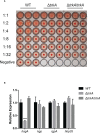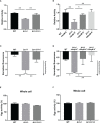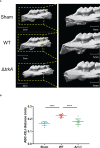TrkA serves as a virulence modulator in Porphyromonas gingivalis by maintaining heme acquisition and pathogenesis
- PMID: 36405968
- PMCID: PMC9666725
- DOI: 10.3389/fcimb.2022.1012316
TrkA serves as a virulence modulator in Porphyromonas gingivalis by maintaining heme acquisition and pathogenesis
Abstract
Periodontitis is an inflammatory disease of the supporting tissues of the teeth, with polymicrobial infection serving as the major pathogenic factor. As a periodontitis-related keystone pathogen, Porphyromonas gingivalis can orchestrate polymicrobial biofilm skewing into dysbiosis. Some metatranscriptomic studies have suggested that modulation of potassium ion uptake might serve as a signal enhancing microbiota nososymbiocity and periodontitis progression. Although the relationship between potassium transport and virulence has been elucidated in some bacteria, less is mentioned about the periodontitis-related pathogen. Herein, we centered on the virulence modulation potential of TrkA, the potassium uptake regulatory protein of P. gingivalis, and uncovered TrkA as the modulator in the heme acquisition process and in maintaining optimal pathogenicity in an experimental murine model of periodontitis. Hemagglutination and hemolytic activities were attenuated in the case of trkA gene loss, and the entire transcriptomic profiling revealed that the trkA gene can control the expression of genes in relation to electron transport chain activity and translation, as well as some transcriptional factors, including cdhR, the regulator of the heme uptake system hmuYR. Collectively, these results link the heme acquisition process to the potassium transporter, providing new insights into the role of potassium ion in P. gingivalis pathogenesis.
Keywords: Porphyromonas gingivalis; heme acquisition; high-throughput sequencing; pathogenicity; potassium ion uptake regulatory protein.
Copyright © 2022 Zou, Zhao, Shen and Wu.
Conflict of interest statement
The authors declare that the research was conducted in the absence of any commercial or financial relationships that could be construed as a potential conflict of interest.
Figures





Similar articles
-
Comparative analysis of Porphyromonas gingivalis A7436 and ATCC 33277 strains reveals differences in the expression of heme acquisition systems.Microbiol Spectr. 2024 Mar 5;12(3):e0286523. doi: 10.1128/spectrum.02865-23. Epub 2024 Jan 30. Microbiol Spectr. 2024. PMID: 38289063 Free PMC article.
-
Regulation of tryptophan-indole metabolic pathway in Porphyromonas gingivalis virulence and microbiota dysbiosis in periodontitis.NPJ Biofilms Microbiomes. 2025 Feb 27;11(1):37. doi: 10.1038/s41522-025-00669-y. NPJ Biofilms Microbiomes. 2025. PMID: 40011497 Free PMC article.
-
Glycation of Host Proteins Increases Pathogenic Potential of Porphyromonas gingivalis.Int J Mol Sci. 2021 Nov 8;22(21):12084. doi: 10.3390/ijms222112084. Int J Mol Sci. 2021. PMID: 34769513 Free PMC article.
-
Heme acquisition mechanisms of Porphyromonas gingivalis - strategies used in a polymicrobial community in a heme-limited host environment.Mol Oral Microbiol. 2017 Feb;32(1):1-23. doi: 10.1111/omi.12149. Epub 2016 Jan 28. Mol Oral Microbiol. 2017. PMID: 26662717 Review.
-
Contribution of -Omics Technologies in the Study of Porphyromonas gingivalis during Periodontitis Pathogenesis: A Minireview.Int J Mol Sci. 2022 Dec 30;24(1):620. doi: 10.3390/ijms24010620. Int J Mol Sci. 2022. PMID: 36614064 Free PMC article. Review.
Cited by
-
Effects of Lacticaseibacillus paracasei L9 on Oral Microbiota and Cariogenic Factors in Streptococcus mutans-Infected Mice.Foods. 2024 Dec 19;13(24):4118. doi: 10.3390/foods13244118. Foods. 2024. PMID: 39767060 Free PMC article.
-
Application of a modified multifunctional short peptide in the treatment of periodontitis.Sci Rep. 2024 Oct 1;14(1):22855. doi: 10.1038/s41598-024-69933-z. Sci Rep. 2024. PMID: 39353971 Free PMC article.
-
Hemophore-like proteins of the HmuY family in the oral and gut microbiome: unraveling the mystery of their evolution.Microbiol Mol Biol Rev. 2024 Mar 27;88(1):e0013123. doi: 10.1128/mmbr.00131-23. Epub 2024 Feb 2. Microbiol Mol Biol Rev. 2024. PMID: 38305743 Free PMC article. Review.
References
-
- Byrne S. J., Dashper S. G., Darby I. B., Adams G. G., Hoffmann B., Reynolds E. C. (2009). Progression of chronic periodontitis can be predicted by the levels of porphyromonas gingivalis and treponema denticola in subgingival plaque. Oral. Microbiol. Immunol. 24 (6), 469–477. doi: 10.1111/j.1399-302X.2009.00544.x - DOI - PubMed
Publication types
MeSH terms
Substances
LinkOut - more resources
Full Text Sources
Molecular Biology Databases
Research Materials

